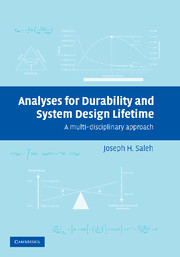Book contents
- Frontmatter
- Contents
- Preface
- 1 Introduction: On Time
- 2 To Reduce or to Extend Durability? A Qualitative Discussion of Issues at Stake
- 3 A Brief History of Economic Thought on Durability
- 4 Analysis of Marginal Cost of Durability and System Cost per Day
- 5 Flawed Metrics: System Cost per Day and Cost per Payload
- 6 Durability Choice and Optimal Design Lifetime for Complex Engineering Systems
- EPILOGUE: Perspectives in Design: The Deacon's Masterpiece and Hundred-Year Aircraft, Spacecraft, and Other Complex Engineering Systems
- APPENDIX A Beyond Cost Models, System Utility or Revenue Models: Example of a Communications Satellite
- APPENDIX B On Durability and Economic Depreciation
- Index
- References
4 - Analysis of Marginal Cost of Durability and System Cost per Day
Published online by Cambridge University Press: 25 October 2009
- Frontmatter
- Contents
- Preface
- 1 Introduction: On Time
- 2 To Reduce or to Extend Durability? A Qualitative Discussion of Issues at Stake
- 3 A Brief History of Economic Thought on Durability
- 4 Analysis of Marginal Cost of Durability and System Cost per Day
- 5 Flawed Metrics: System Cost per Day and Cost per Payload
- 6 Durability Choice and Optimal Design Lifetime for Complex Engineering Systems
- EPILOGUE: Perspectives in Design: The Deacon's Masterpiece and Hundred-Year Aircraft, Spacecraft, and Other Complex Engineering Systems
- APPENDIX A Beyond Cost Models, System Utility or Revenue Models: Example of a Communications Satellite
- APPENDIX B On Durability and Economic Depreciation
- Index
- References
Summary
PREVIEW AND GUIDE TO THE CHAPTER
Analysis of the marginal cost of durability is a prerequisite for addressing the durability choice problem. This straightforward observation is often forgotten in the economic literature on durable goods, or dismissed by making the unrealistic assumption that the marginal cost of durability is zero. The details of a marginal cost of durability analysis are system-specific. A satellite example is discussed to illustrate the essence and provide a quantitative application of such analysis. First, the impacts of the durability requirement on different subsystems on board the spacecraft are quantitatively explored, that is, how the different subsystems (power, propulsion, thermal, etc.) scale with increased durability; second, the effects of durability on the different subsystems are integrated and typical satellite cost profiles are provided as a function of durability. The result represents the marginal cost of durability of a satellite. In addition to the satellite example, two related metrics are introduced, the cost elasticity of durability and the cost per day, which allow a clear understanding and visualization of the economies of scale, if any, that result from extended durability. This chapter contributes a necessary first step toward a rational choice of durability for engineering systems from a customer's perspective.
Introduction
The first chapter introduced two broad categories of questions related to an artifact's durability: the technicalities of durability, and the choice of durability.
- Type
- Chapter
- Information
- Analyses for Durability and System Design LifetimeA Multidisciplinary Approach, pp. 53 - 80Publisher: Cambridge University PressPrint publication year: 2007



